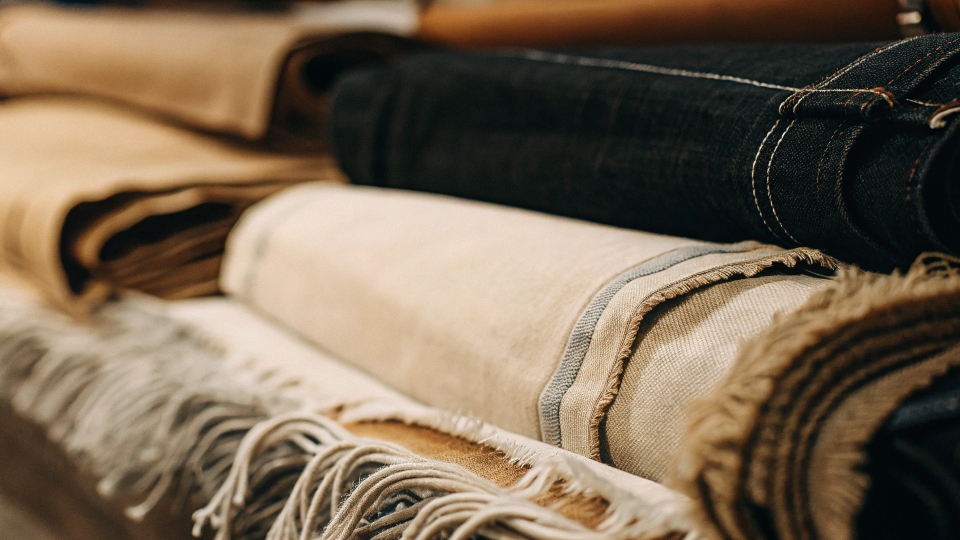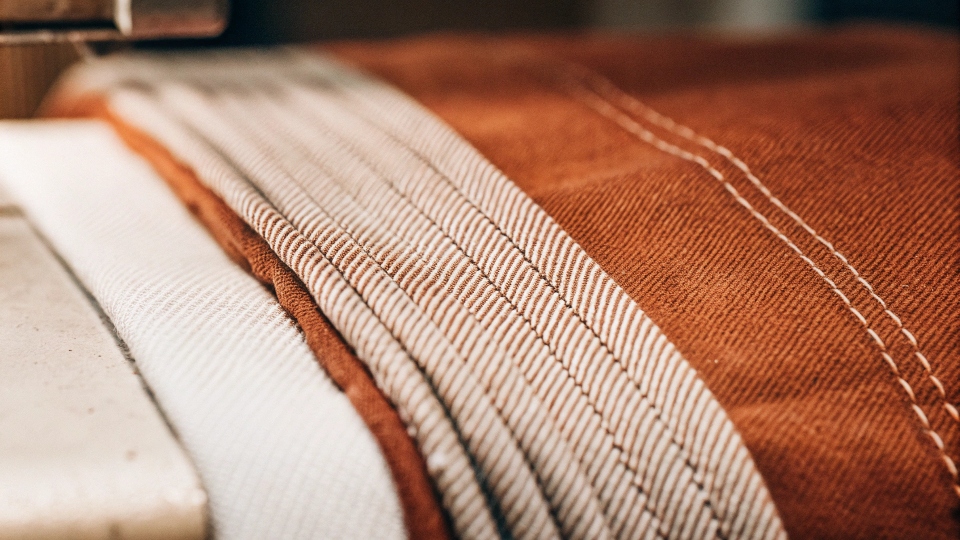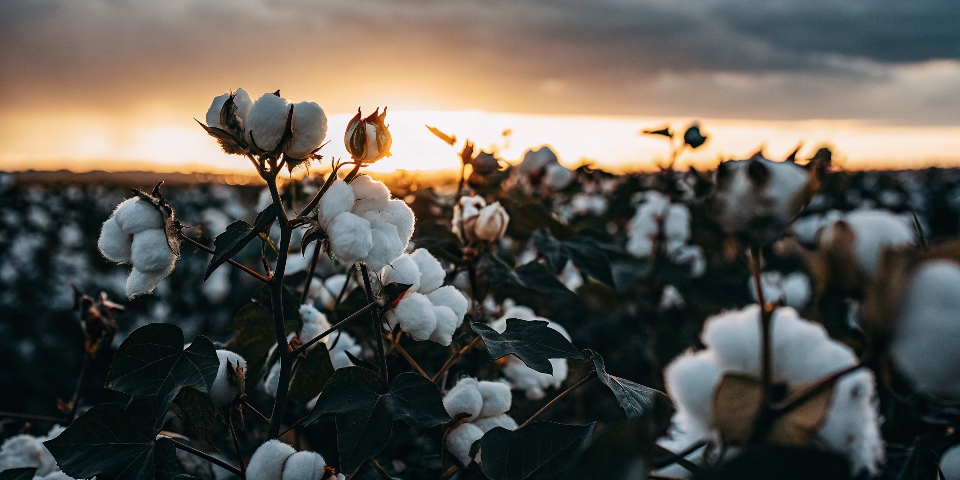You know that modern jeans feel different, but you're not sure why. The endless fabric options—stretch, soft, rigid—are confusing, making it hard to choose the right material for your design.
While jeans are traditionally made from 100% cotton, most modern denim is a blend. These blends mix cotton with fibers like elastane for stretch, polyester for durability, and Tencel™ for a soft, drapey feel. The fiber blend defines the final product.
As someone who has been running a denim factory for over 20 years, I see every fiber combination imaginable. The choice is no longer just "cotton." It's a strategic decision that affects the comfort, look, durability, and price of the final garment.
For a designer like Dean, understanding these fibers is the key to turning a creative vision into a successful product. Let's break down the materials that make up the jeans we wear today.
Which fiber is used in jeans?
You see terms like "comfort stretch" and "shape retention" on hangtags. But what are the actual fibers inside the fabric that create these specific qualities?
The primary fiber in jeans is almost always cotton. For performance, it's blended with other fibers. The most common addition is elastane (Spandex/Lycra) for stretch, followed by polyester for added strength and wrinkle resistance.
[^1], and a polyester thread all pointing towards a pair of modern jeans.](https://diznewjeans.com/wp-content/uploads/2025/07/the-primary-fiber-in-jeans-is-almost-alwa-1.jpg)
At my factory, DiZNEW, we handle a wide range of fiber blends every day. Each one is chosen to achieve a specific result for the client. While 100% cotton is the timeless classic, blends now dominate the market because they solve specific problems for the wearer.
A designer needs to think about the end-use.Are you creating a rugged, traditional jean or a super-soft, comfortable skinny jean? The answer will determine your fiber choice. Here is a breakdown of the most common fiber compositions I work with and why a brand would choose them.
| Fiber Composition | Key Advantages | Best For |
|---|---|---|
| 100% Cotton | Breathable, durable, comfortable, develops a beautiful patina. | Authentic vintage looks, classic workwear, and raw denim. |
| Cotton + Elastane | Adds comfort and stretch, allows for a closer fit. | Skinny jeans, slim-fit styles, and everyday comfort. |
| Cotton + Polyester + Elastane | Excellent stretch and recovery, durable, and holds its shape. | Super-skinny or performance jeans that won't bag out. |
| Cotton + Tencel™ (Lyocell) | Very soft, has a beautiful drape, breathable, and feels silky. | Luxury jeans, fashion-forward wide-leg styles, and soft denim. |
| Cotton + Acetate | Soft, cool to the touch, has a unique, high-end luster. | Premium, fashion-focused jeans with a distinct sheen and feel. |
What type of fabric is used to make jeans?
You know jeans are made of "denim," but that word doesn't explain what it actually is. What is the specific structure of this fabric that makes it so strong and unique?
Jeans are made from a type of fabric called denim. Denim is a sturdy cotton twill fabric, where the weft thread passes under two or more warp threads, creating the signature diagonal ribbing you can see on the surface.
The secret to denim's strength and iconic look lies in its specific weave. When we get fabric rolls at the factory, the first thing we inspect is the quality of this weave.
It's a twill weave1, which is different from a simple plain weave like in a basic bedsheet. In a twill weave, the crosswise thread (called the "weft") goes under two or more lengthwise threads (the "warp"). This creates a pattern of diagonal, parallel ribs. This structure makes the fabric much stronger and more durable than a plain weave.
Another key part of traditional denim is the dyeing process. The warp threads are dyed with indigo blue, but the weft threads are left white. When these are woven together, you get the classic denim look: mostly blue on the outside, but with tiny flecks of white showing through.
This is also why jeans fade so beautifully. As the blue warp threads wear down, more of the white weft threads underneath are revealed, creating a unique pattern for every person who wears them.
What natural fiber is used to make denim?
With all the new blended fabrics available, you might wonder if denim is even a natural product anymore. What is the original, natural foundation of this iconic material?
The essential natural fiber used to make denim is cotton. Cotton provides the core strength, breathability, and classic feel that people associate with jeans. Even in modern blends, cotton is almost always the main ingredient.
Cotton is the heart and soul of denim. It's been the primary material since the very beginning, and for good reason. Cotton fibers are strong and durable, which was essential for the original workwear purpose of jeans.
It’s also very breathable and absorbs moisture, which makes it comfortable to wear in different climates.From a manufacturing standpoint, cotton takes indigo dye extremely well, allowing for the deep, rich blue color that is so iconic.
Over the years, the demand for sustainability has also pushed the industry forward. Brands now frequently ask me to source specific types of cotton. This includes organic cotton, which is grown without synthetic pesticides, or cotton from the Better Cotton Initiative2 (BCI), which promotes more sustainable farming practices.
So while we add other fibers for performance, everything starts with this incredible natural fiber. Its qualities are the reason we fell in love with jeans in the first place.
Are jeans made of synthetic fibers?
You hear about polyester and elastane being used in jeans. It makes you question if you're designing with natural fabrics or just creating a pair of plastic pants.
No, jeans are not fundamentally synthetic. Classic jeans are 100% natural cotton. Most modern jeans are a blend, using synthetic fibers as a performance enhancer, not as the main material. They add stretch and durability to a cotton base.
This is a very common question, and the answer is all about partnership. It's not a choice between natural or synthetic; it's about using synthetics to improve the natural qualities of cotton.
At my factory, we never make a 100% polyester3 jean. Cotton is always the foundation, usually making up 90% or more of the fabric content. We add small amounts of synthetic fibers to give the jeans abilities that cotton alone doesn't have.
Think of it this way: we add a little bit of elastane (usually 1-2%) to give the jeans comfort and stretch, so they move with your body. We might add some polyester (around 5-10%) to help the jeans keep their shape and prevent them from bagging out at the knees after a long day.
There are also interesting fibers like Tencel™4 (Lyocell), which are called "regenerated cellulosic fibers." They start from a natural source like wood pulp but are man-made.
These add incredible softness and drape. So, synthetics are not taking over jeans; they are working as a support team to make a cotton-based product even better.
Conclusion
Jeans begin with the natural strength of cotton. Modern denim then strategically blends in fibers like elastane, polyester, and Tencel to create the perfect balance of comfort, durability, and style.
-
Learn about the twill weave that gives denim its strength and iconic look. ↩
-
Understand how the Better Cotton Initiative promotes sustainable cotton farming. ↩
-
Discover how polyester contributes to the durability and wrinkle resistance of jeans. ↩
-
Find out how Tencel™ enhances the softness and drape of denim, making it a luxury choice. ↩










